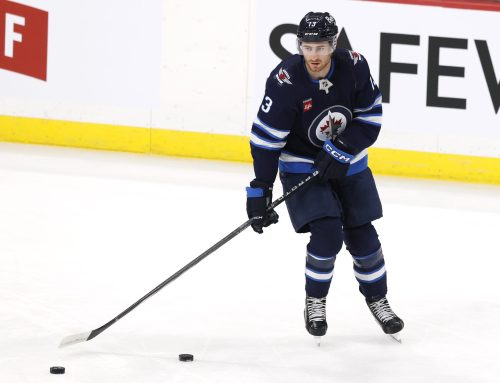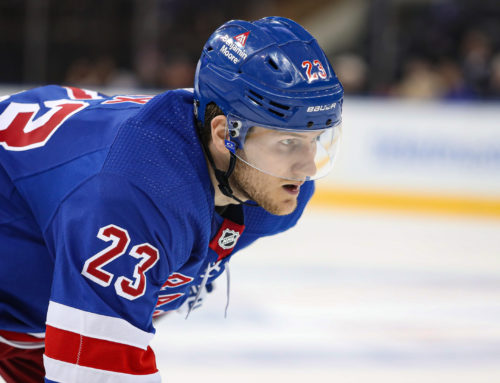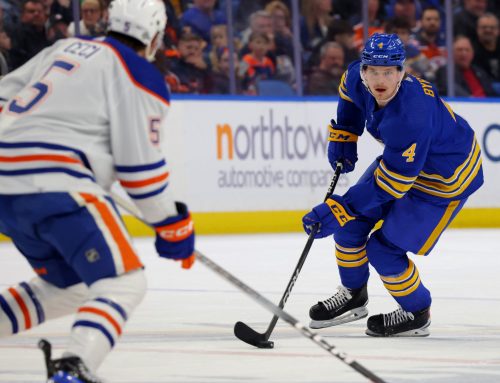
It doesn’t look like Anton Stralman will be returning to the Tampa Bay lineup anytime soon. He has played three games since the end of February and may not be ready for any point in the first round. Assuming there isn’t an upset, the Lightning don’t really need him right now and as I’ll get into a little later, they have a lot of defensive depth. That doesn’t mean this isn’t a loss for the team.
*
Jaccob Slavin missed Carolina’s practice on Wednesday due to personal reasons. The reasons were not expounded upon but let’s just hope there’s nothing serious going on behind the scenes.
*
A little nugget from Elliotte Friedman’s ’31 Thoughts’ column at Sportsnet: it appears the Avalanche may get, and suit up, Cale Makar following the NCAA’s Frozen Four. The semi-final games take place Thursday with the final on Saturday.
Not that I’m not looking forward to seeing Makar in the NHL, but what an introduction to the top professional hockey league; “Here ya go kid, you’re starting your career in a playoff series against the top team in the West.”
*
I was having a conversation with some friends yesterday about the playoffs and we were talking about the Tampa Bay blue line. Victor Hedman (rightfully) gets all the publicity and most people recognize Ryan McDonagh as excellent. Anton Stralman has long been one of the best defensive blue liners in the NHL and is still very solid when he’s healthy. Mikhail Sergachev has been heralded since being traded for Jonathan Drouin, and though his production took a step back from 2017-18, he still had a very good year in other areas. He’s a star in the making.
But it’s Eric Cernak that really brings it all together.
Using Evolving Hockey’s goals above replacement totals, Cernak was fourth in the league among blue liners with 750 minutes at even strength. Using Corsica’s wins above replacement, Cernak was in the top-50 league-wide, just behind Ryan McDonagh. He’s been better defensively than offensively, but this team does not need more offence.
One season of 58 games does not make a career. However, this is a fantastic start to Cernak’s career. He’ll likely be stuck behind both Hedman and Sergachev, at least, on the power-play depth chart so actual point upside will be limited. However, we’ve seen the excellent peripherals (nearly 200 hits and nearly 80 blocks) in limited time. In a full season, he could be a 30-point guy with great peripheral stats. That is very valuable in multi-cat leagues.
*
The postseason did not take long to show its teeth as Tampa Bay blew a 3-0 lead in Game 1 to Columbus, losing 4-3 in regulation. Josh Anderson had a goal and an assist, the tally coming short-handed. Both David Savard and Seth Jones scored from the blue line, the latter being a game-winning goal on the power play with about six minutes left.
Anderson had the second-lowest ice time total of any Columbus forward.
Savard, by the way, had a marvelous season for Columbus. To be honest, outside of Sergei Bobrovsky, he was probably Columbus’s best player in this game. It’s a shame he’s stuck behind Seth Jones and Zach Werenski on the PP depth chart. I would like to see him get top power play minutes sometime.
*
It was a raucous crowd at the Coliseum for Game 1 between the Penguins and the Islanders. It was our first overtime of the postseason as Justin Schultz tied the game at three with about 90 seconds left and the goalie pulled.
Josh Bailey cleaned up a rebound on a beautiful play by Mathew Barzal to take the game 4-3 in overtime. Robin Lehner, despite the three goals, was marvelous in the 41-save win.
I’m interested to see what Lehner’s contract ends up being this summer. A lengthy postseason run could mean a significant pay raise. Cap league owners are watching carefully.
*
Tyler Bozak scored with about two minutes remaining in the third period to lift the St. Louis Blues to a 2-1 win in Game 1 against Winnipeg. It wasn’t quite the high-paced affair that Nashville-Winnipeg was in last year’s playoffs, but I think we were kind of expecting that.
I didn’t watch the entire game (there was a lot of sports going on), but in the few shifts I caught Josh Morrissey, he looked fine. That is to say, he wasn’t noticeably labouring, that I saw.
*
Dallas struck first in their series with Nashville, taking a 3-2 road win in Game 1. The hero was rookie defenceman Miro Heiskanen, who had two goals, including one on the power play. This is the type of player who is more than capable of having a big breakout performance these playoffs, one that may take a lot of casual hockey fans by surprise.
Mats Zuccarello scored what ended up being the game-winning goal.
*
It was a rough first game for San Jose, health-wise at least, as both Timo Meier and Joe Pavelski got hit in the face – Meier from a stick and Pavelski from a puck – that required them to leave the first period. Both would return, and Pavelski’s puck-to-the-face directly resulted in a goal, but Pavelski was clearly missing teeth and had a jaw protector for the rest of the game. Just something to keep an eye on.
San Jose would take the first meeting 5-2.
Brent Burns had a stellar fantasy evening with a goal, assists, three shots, four blocks, and two hits. Erik Karlsson looked like the Erik Karlsson we’ve always known, which is great for the Sharks and bad for the rest of the West.
*
A few months ago, I wrote about production from the blue line in the 2018-19 season. The changing nature of the position over the last four or five years has been a big shift in how the position is played, which types of players succeed, and of course, production. In those Ramblings, I pointed out how the number of 40-point defencemen had been relatively consistent from 2013-2017 before spiking up to 30 such blue liners in 2017-18. As mentioned in those Ramblings, scoring was up in 2017-18 so that we had more rearguards crack 40 points than we had seen in years wasn’t a huge surprise.
The surprise? With scoring up through the first half of 2018-19, the number of defencemen on pace for at least 40 points declined.
By the time the 2018-19 season finished, we had the highest scoring year (3.01 goals per team per game) since 2005-06 (3.08). It would make sense that we would have more than 30 different 40-point defencemen as we had in 2017-18 then, right? Well, that wasn’t the case, as we had exactly 30 blue liners reach the 40-point plateau, the same number as 2017-18. There were 128 more goals this year than last, but we had the same number of 40-point performances from the rearguards.
What gives?
Well, there weren’t more top-end performers. Not really, anyway, as we had six defencemen crack the 60-point mark this year while we had as seven such defencemen last year. It’s certainly more than there were four or five years ago when we typically had two or three, but that hasn’t increased from last year. Now, there was an increase at the highs of the top-end as we had four d-men crack 70 points where none accomplished that the year prior.
Defencemen got in on the action more than in 2017-18, too. This season, there were 7577 goals scored in the NHL, and there were 5049 points by defencemen, meaning every goal averaged 0.666 points for a defenceman (insert Devils joke here). Last year, there were 7449 goals scored in the NHL, and there were 5022 points by defencemen, meaning every goal averaged 0.674 points by a blue liner. So, this year, defencemen got in on the goals less often than a year ago, and we had the same number of 40-point guys, but the elite defencemen saw more production.
I’m not going to dig a whole lot further into this right now. There is a lot to dissect on why this might happen; is it random, are there changes in ice time allocation to consider, or is it something else entirely? It’s going to require a lot more thought than just pointing the actual changes themselves. I’ll circle back to this in the offseason.
*
On the topic of 70-point defencemen, as I mentioned, there were four of them in 2018-19. The last time the NHL saw four defencemen crack 70 points in the same season? That was 1995-96, when Chris Chelios, Paul Coffey, Ray Bourque, and Brian Leetch all managed at least 70. Even in 2005-06, the highest scoring season post-2005 lockout, there were only two blue liners reach 70 points: Sergei Zubov and Nicklas Lidstrom.
*
Let’s switch focus to goal scoring from the blue line for a second. As stated earlier, goal scoring was up league-wide this year, as the average team scored 0.04 more goals per game than in 2017-18. We would expect a corresponding rise in goal scoring from defencemen, then, right? Not so fast.
In 2017-18, there were 81 238 shots on goal, in total, across the entire league. Of those 81 238 shots, 24 225 came from defencemen, resulting in 1158 goals. That means defencemen landed 29.86 percent of all shots on goal and scored 15.55 percent of all goals (1158 out of 7449).
Contrast the paragraph above with numbers from 2018-19: there were 79 954 shots on goal across the league and 23 458 came from the blue line, resulting in 1125 goals. That means defencemen landed 29.34 percent of shots on goal and scored 14.85 percent of all tallies.
Let’s summarize all this, then:
- Goals were up across the league in 2018-19 compared to the season before
- Even though goals went up, shots on goal went down (and PP percentage went down as well)
- Even though goals went up, defencemen scored a lower percentage of goals compared to 2017-18, and flat-out scored fewer goals in total
Just for a frame of reference, in 2016-17, defencemen scored 15.41 percent of all goals. So, over the last three seasons, 2018-19 does seem an aberration in goal scoring from the blue line.
I do wonder about tactical shifts in the NHL. We see enough seam passes or plays from behind the net to know that coaches are undoubtedly approaching the game differently than five years ago. Is there a push to get defencemen to shoot less often? That would make sense. Most coaches want their defencemen being the engines of the rush of the offence, but probably not the finishers.
Anyway, as I mentioned earlier, this is going to take a lot more research than one Wednesday afternoon in April. I’ll circle back to this in a couple months but it’s certainly a good time to be an NHL fan if you like goal scoring.





 FLA
FLA CHI
CHI NYR
NYR PIT
PIT L.A
L.A COL
COL CBJ
CBJ ANA
ANA MTL
MTL TOR
TOR WPG
WPG S.J
S.J SEA
SEA BOS
BOS VAN
VAN
